|
|
|
Sort Order |
|
|
|
Items / Page
|
|
|
|
|
|
|
| Srl | Item |
| 1 |
ID:
116049
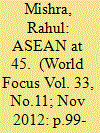

|
|
|
| 2 |
ID:
146011
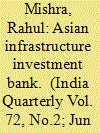

|
|
|
|
|
| Summary/Abstract |
Lauded as one of the most remarkable Chinese initiatives in the international financial arena, the Asian Infrastructure Investment Bank (AIIB) sets the stage for China’s greater role in the international economic system as a prominent stakeholder. Headquartered in Beijing, the bank is expected to play a key role in plugging the infrastructure gaps in Asia, which have been estimated at US$8 trillion between the years 2010 and 2020. The setting up of the AIIB will have far-reaching economic as well as politico-strategic implications for countries across Asia and beyond. While the AIIB has been seen as a remedy to address infrastructure deficit in Asia, it is unlikely to meet the US$8 trillion goal on its own. The biggest challenge before the bank, therefore, is to prioritise in terms of selecting projects so that it optimally utilises the available financial resources and functions as a transparent and impartial organisation, in addition to making a swift and smooth transition from a ‘Chinese initiative’ to a ‘China-led initiative’ that yields equitable benefits to all its member countries.
|
|
|
|
|
|
|
|
|
|
|
|
|
|
|
|
| 3 |
ID:
126112
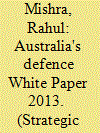

|
|
|
|
|
| Publication |
2013.
|
| Summary/Abstract |
On 3 May 2013, Australia's former Prime Minister Julia Gillard released the Defence White Paper (DWP) 2013, making it the sixth White Paper on defence in the history of Australia, and the third since 2000. The last Defence White Paper, entitled Defending Australia in the Asia Pacific Century: Force 2030, was released in 2009 when Prime Minister Kevin Rudd was serving his first term.
Seemingly, the DWP 2013 is Australia's roadmap on matters of national security, defence and security policy and priorities. Highlighting the significance of DWPs for Australia, the Department of Defence of Australia notes:
The Defence White Papers are the government's principal policy direction to the Department of Defence. They present long-term strategic direction, government commitments, and future capability requirements. Within the Department, the White Papers inform the development of more detailed planning, capability, workforce, preparedness, and financial guidance.
|
|
|
|
|
|
|
|
|
|
|
|
|
|
|
|
| 4 |
ID:
125511


|
|
|
|
|
| Publication |
2013.
|
| Summary/Abstract |
One of the most dramatic events in the twenty first century Asia, as it is turning out has been the rise of People's Republic of China (henceforth China). Equally dramatic has been the ongoing reform process and opening up of Myanmar to the outside world. Intriguingly enough, the China-Myanmar bilateral relationship has also been full of surprises, drawing the attention of policy makers and foreign policy pundits alike.
|
|
|
|
|
|
|
|
|
|
|
|
|
|
|
|
| 5 |
ID:
157807


|
|
|
|
|
| Summary/Abstract |
In a departure from its previous stance, China, in August 2017 during the Association of Southeast Asian Nations (ASEAN) Foreign Ministers' meeting, stated that it Beijing was willing to discuss the possibility of re-engaging in a dialogue on the Code of Conduct (CoC) in the South China Sea. The CoC is not a new idea in the region in terms of finding an amicable solution to the South China Sea dispute, which involves China, Taiwan, Vietnam, Brunei, Malaysia, and the Philippines. In 2002, China and the ASEAN member countries officially engaged in formalising the CoC for the first time. However, the CoC finally agreed to was non-binding in nature. While the decision recently taken by the ASEAN countries and China in restarting the negotiations to discuss the CoC again has been seen as a positive move, it is widely believed that, keeping in view China's assertive posture, it is not likely to agree to the CoC anytime soon.
This paper discusses the origin and evolution of the CoC in the South China Sea, provides an analysis of China's behaviour with regard to the CoC, and concludes by listing the future prospects for the CoC in the South China Sea.
|
|
|
|
|
|
|
|
|
|
|
|
|
|
|
|
| 6 |
ID:
096016
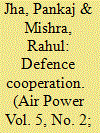

|
|
|
| 7 |
ID:
083722
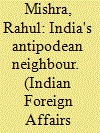

|
|
|
| 8 |
ID:
123301
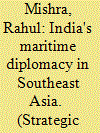

|
|
|
|
|
| Publication |
2013.
|
| Summary/Abstract |
INS Sudarshini, India's Sail Training Ship (STS), was sent on a commemorative expedition to the Association of South East Asian Nations (ASEAN) member countries for six months along the monsoon trade winds route to trace India's civilisational and cultural affinities and rejuvenate trade and maritime linkages with its neighbours in the East. The voyage was part of the commemoration of the successful completion of two decades of India's Look East Policy, 20 years of dialogue relations with ASEAN, and 10 years of India-ASEAN summit-level partnership. The expedition, a collaborative venture of India's Ministries of Defence and External Affairs, traced sea routes developed centuries ago, linking India with countries of the Southeast Asian region. The heartening reception of the INS Sudarshini expedition across the Southeast Asian region has underscored the point that India's maritime diplomacy has been a success in the region. The expedition also highlights the point that since India and Southeast Asia are immediate neighbours, there is a need to work towards ensuring greater connectivity between India and the countries of the region. As part of the commemoration, an India-ASEAN car rally was also organised, covering about 8,000 km and nine out of 10 ASEAN states. It is worth mentioning that India shares a land boundary with Myanmar and a maritime boundary with three Southeast Asian nations. The success of the INS Sudarshini expedition (and the India-ASEAN car rally) clearly indicates that compared to the situation during the 1980s and early 1990s, a substantive perceptual change has come about in the Southeast Asian approach towards India.
|
|
|
|
|
|
|
|
|
|
|
|
|
|
|
|
| 9 |
ID:
099646
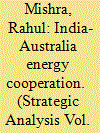

|
|
|
| 10 |
ID:
114349
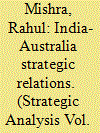

|
|
|
|
|
| Publication |
2012.
|
| Summary/Abstract |
This commentary attempts to put into perspective the recent developments in India-Australia bilateral ties. It argues that economic incentives and strategic calculations have compelled Australia to get closer to India. Australia's decision to supply yellowcake to India, expanding bilateral naval cooperation and Australian Defence Minister Stephen Smith's December 2011 visit should be seen in that context. Australia has realised that it does not make sense to lag behind when countries across the world are jockeying to benefit from India's rise.
|
|
|
|
|
|
|
|
|
|
|
|
|
|
|
|
| 11 |
ID:
163278
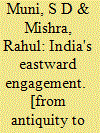

|
|
|
|
|
| Publication |
New Delhi, Sage Publications India Pvt Ltd, 2019.
|
| Description |
xiv, 329p.hbk
|
| Standard Number |
9789353282684
|
|
|
|
|
|
|
|
|
|
|
|
Copies: C:1/I:0,R:0,Q:0
Circulation
| Accession# | Call# | Current Location | Status | Policy | Location |
| 059583 | 327.5405/MUN 059583 | Main | On Shelf | General | |
|
|
|
|
| 12 |
ID:
131573


|
|
|
|
|
| Publication |
2014.
|
| Summary/Abstract |
Myanmar is swiftly gaining traction in India's Look East policy. With regular exchange of high-level visits, deepening economic cooperation and cross-border rail, road and air connectivity, the relationship is likely to strengthen. A carefully crafted Myanmar policy, which is practical and implementable, is a must if India does not want to miss the fresh opportunity to engage the 'Golden land'.
|
|
|
|
|
|
|
|
|
|
|
|
|
|
|
|
| 13 |
ID:
180084
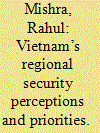

|
|
|
|
|
| Summary/Abstract |
Over the past several decades, India and Vietnam have consolidated their relationship through bilateral engagements, which have been complemented by the Association of Southeast Asian Nations (ASEAN)-led multilateral mechanisms such as the East Asia Summit, ASEAN Regional Forum, ASEAN Defence Ministers’ Meeting Plus and the India-led Mekong–Ganga Cooperation (MGC). Building up on their traditionally strong relations, India and Vietnam have widened and deepened their defence and strategic links in recent years, which is manifested in joint trainings, military exercises and defence Lines of Credit offered by India. Since the 1990s, especially over the last decade, both India and Vietnam have made strategic readjustments to elevate their respective bilateral ties with like-minded countries bringing about new commonalities in their politico-strategic visions and policies. Like India, Vietnam too is trying to bring the multilateral and multi-dimensional Indo-Pacific agenda to the mainstream of its foreign policy calculations, facilitated by greater warmth in ties with Japan and the US. Vietnam’s embracing of the Indo-Pacific is also in sync with ASEAN’s Outlook on Indo-Pacific. It also aligns well with Vietnam’s long-standing policy of ‘Three Nos’, expanded to four in its 2019 Defence White Paper. While recent developments in the South China Sea have exacerbated Vietnam’s growing anxieties vis-à-vis China, considering its trade interlinkages and dependence on China (and Russia), it is apparent that Vietnam is not yet ready to uproot its multilayered linkages with China and get on board the ‘Quad Plus’ initiative that is perceived as an overtly anti-China coalition of democracies. India–Vietnam ties, therefore, must rely on the bilateral plank along with ASEAN-linked mechanisms, MGC and the Indo-Pacific construct while trying to develop concerted actions through deeper cooperation with Japan and the US. In short, any initiative to include Vietnam in a Quad Plus mechanism without sufficiently developing synergies with individual countries would not yield desired outcomes. This article argues that India–Vietnam ties would benefit most by attaching their bilateral pillar of relationship with the ASEAN- and Indo-Pacific-centred inclusive multilateral mechanisms while gradually engaging the US, Japan and other potential partners in suitable frameworks.
|
|
|
|
|
|
|
|
|
|
|
|
|
|
|
|
|
|
|
|
|